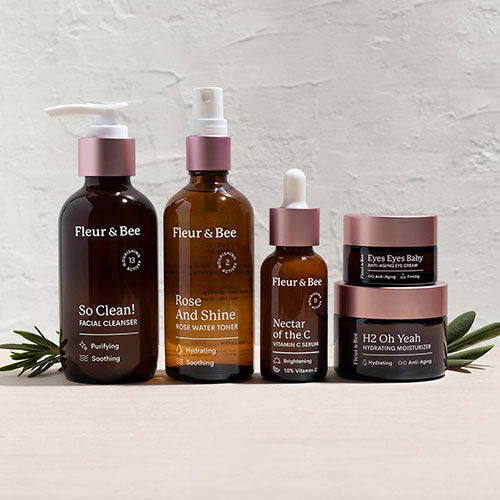Perhaps you’re seemingly doing all the right things for your skin, but you’re still dealing with unwanted challenges. Whatever your skincare queries, there is no reason to go it alone - especially when professional assistance is often just a quick physician’s visit away. Dermatologists can offer heaps of help when setting out on a skincare journey. Keep reading to learn when is the best time to start seeing a dermatologist.
IN A NUTSHELL
Main Takeaways: While dermatologists can guide you through a universe-worth of skin issues, they’re not just for damage control. To proactively protect the health of your skin, elicit the help of a dermatologist today.
Good to Know: It’s great to plan for yearly dermatological checkups, but there are a few reasons you shouldn’t wait until your annual. Keep reading to learn the non-negotiable cues for an ASAP visit.
Recommended Products: Deluxe Set.
What Is a Dermatologist
Specializing in the care and maintenance of all things skin, hair, and nails, a dermatologist is a physician who has undergone extensive training to skillfully identify and treat thousands of conditions and support your skin-related goals. Depending on your needs, dermatologists may provide medical, cosmetic, therapeutic, and sometimes surgical solutions to help you achieve the skin of your dreams.
What to Expect
Your skin is your body’s largest organ and the first line of defense against literally everything, so it needs to be checked closely. Consequently, a dermatologist will give an up-close full-body examination. This could feel daunting, but know there are ways to make the experience more comfortable. Professional physicians should put you at ease and encourage you to remain covered-up while they examine only small areas of skin at a time. Many offices will allow new patients to bring a support person or provide one for you. So, if your upcoming visit brings on feelings of nervousness and vulnerability, be upfront about it so you and your clinician can have solutions in place to assuage your valid anxieties.
When to See a Dermatologist
To proactively protect your skin, any time is the right time to elicit the help of a trusted dermatologist. Further, everyone’s skin is different, so while acne or hormonal breakouts may have some frequenting their dermatologists as early as their preteen years, others may not have reason to pop on in until much later. While there may not be a magic age to start consulting with a dermatologist, most pros agree that if you haven’t yet done so by your mid-twenties, you might want to consider it. By this time, most people have learned what their skin likes and what it doesn’t. They know it well enough to be able to speak on its nuances and any potential changes. Most importantly, by one’s twenties, your skin very likely has been on the receiving end of enough UV rays to start being mindful of their effects. This time of your life is usually early enough to successfully get ahead of age defense.
Similar to routine primary care checkups, it is good practice to check in with your dermatologist regularly; once a year is usually standard, unless otherwise directed by your doctor. These annual visits will cover all the basics and should include a full body exam and a comprehensive rundown of all your skin’s non-urgent trials and tribulations to best ensure healthy, beautiful skin in the year ahead.
While it is important to keep up with your routine visits, there may be times that you shouldn’t wait for your annual check-up. If you notice any of the following, pay your derm a visit, ASAP.
Top 5 Reasons to Visit a Dermatologist
1. A Changing or Irregular Mole
A mole, also known as a nevus or beauty mark, is a common, often semi-permanent growth on the skin. There are many different kinds of moles and, while most are harmless, some can be an indication of more nefarious skin activity, like cancer. So, it is important to pay close attention to your moles, monitor them for any changes in appearance, and know your ABCDEs:
- Asymmetry: Moles should be equal on all sides, with any “half” mirroring the other.
- Border: Borders of moles should be smooth; never jagged, blurred, or “lacey”.
- Color: Moles should be consistent in color and either tan, brown, or black. If you notice a mole that is a blend of colors, changing color, darker than all your other moles, or showing hues of white, blue, or red, get it checked.
- Diameter: Harmless moles are usually no larger than ¼ inch in diameter, or about the size of a pencil eraser.
- Evolving: Any mole that is actively changing, no matter its shape, size, or color, warrants a trip to the dermatologist. Don’t wait. Just go.
2. Acne or Persistent Breakouts
Believe it or not, acne is a medical condition and deserves the attention of a professional. There are many treatment options available, many of which are only accessible through your doctor. If you are experiencing relentless breakouts, or painful cystic blemishes, don’t try to manage it yourself, as waiting could lead to things like infection and scarring.
3. Hives, Rashes, or Persistent Irritation
A chronic, clinical skin condition could be the cause of all that itchy, scratchy, redness you just can’t seem to kick. Genetics or allergies are possibly explanations why you may be suffering from hives, rashes or irritated skin. The reasons why can only be better understood through medical testing.
4. Nail Woes
While our nails often feel like nothing more than accessories, any associated conditions, like fungal infections or in-growns, shouldn’t be ignored. Without proper treatment, they can become dangerous. Further, ailing nails can signal larger problems, such as potential liver, heart, or endocrine issues.
5. Hair Loss
Wash day getting you down with handfuls of lifeless strands foregoing their follicles? Your dermatologist can offer you a host of therapies to minimize the impact of hair loss and prevent it from progressing into a major bummer.
Make Your Visit Work for You
Make the most of your time at the derm’s office by loving and caring your skin in advance. Treat it with high-quality products and always note any changes in its appearance. Keep a text doc in your phone so you can easily share important information with your doctor. And don’t skip your visit! Some scheduled time with a trusted pro just might be the missing ingredient in your holistically-healthy skin recipe.





